New York state houses 17 different species of snakes. Although many fear snakes, they play an important role in the environment. They are an integral part of keeping vermin in cities at bay. For example, a single rat snake can eat over 100 rodents yearly. Furthermore, other snakes help control the insect and invertebrate populations in cities. They also form part of the diet of other predators, such as foxes and hawks. The most sighted snakes in New York include the water and garter snakes. The water snake occurs in almost any water body, including one of the most snake-infested rivers in New York, the Hudson River.

Other Snakes Found In New York
The milk snake is believed to have gotten its name from the misconception that it can milk cows. They like to hide in barns looking for rodents or other snakes to prey on. Additionally, they are tan or light gray with reddish or brown splotches on their bodies. They are also known as “spotted adders” in some regions but are harmless to humans.
The biggest snake found in New York is the black rat snake. This snake can reach up to eight feet long. They are mostly black and prey on birds and small mammals by constricting them. Snakes found along the rivers of New York include the Northern water snake, plain-bellied water snake, diamondback water snake, brown water snake, garter snake, copperhead, and eastern racer.
Hudson River: One of the Most Snake-Infested Rivers in New York
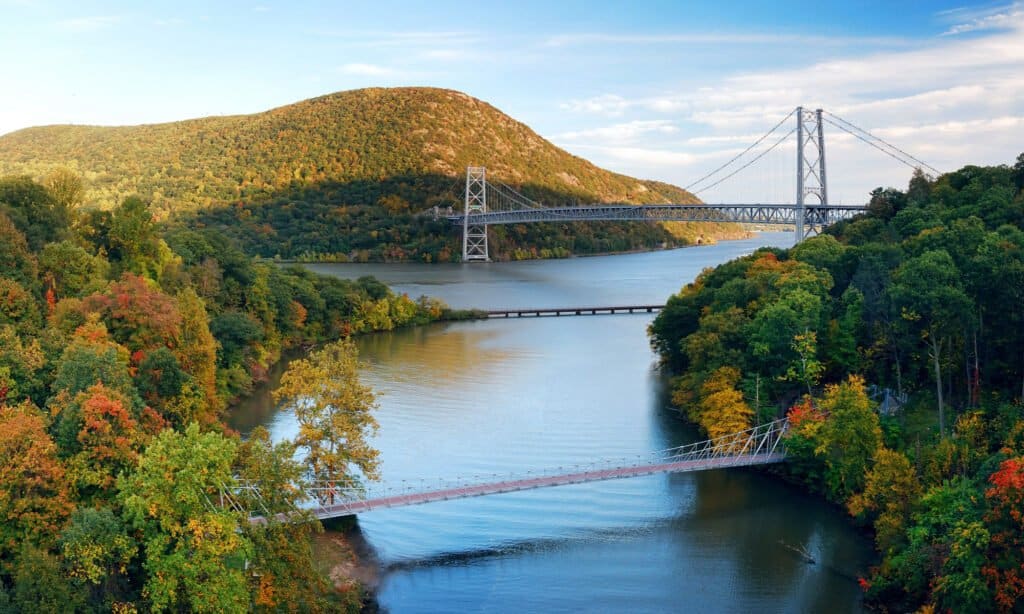
The Hudson River flows through most of New York State.
©Songquan Deng/Shutterstock.com
The Hudson River is one of the most snake-infested rivers in New York, and it starts at several small lakes in the Adirondack Mountains. However, Lake Tear of Clouds is considered the main source. It flows mostly through the State of New York. Towards the end, it forms the boundary between New Jersey and New York.
Northern Water Snake
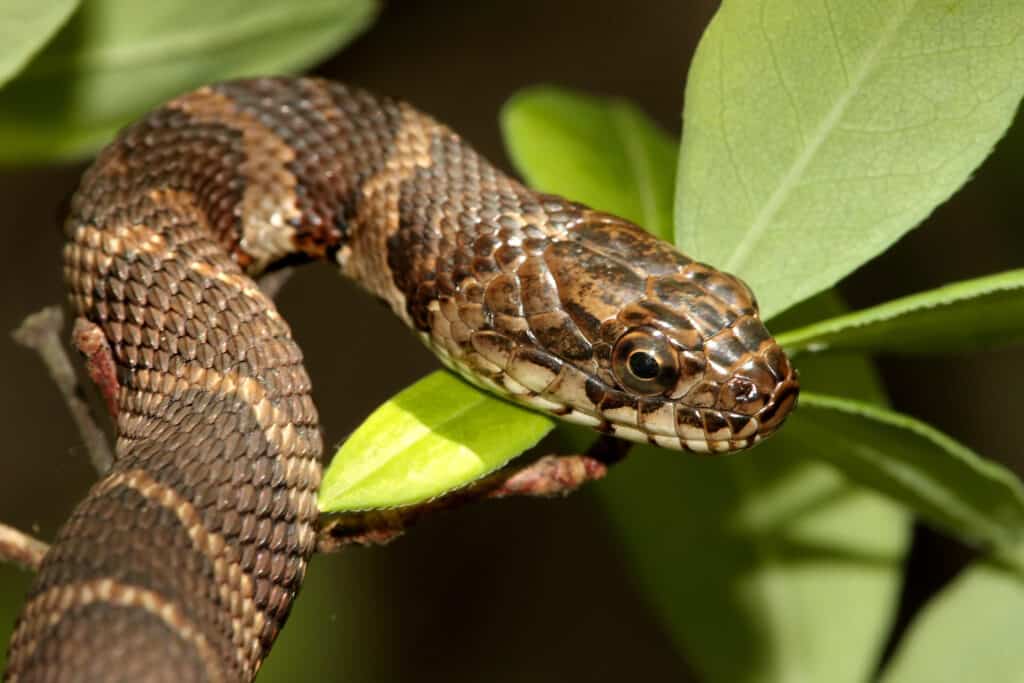
Northern water snakes swallow their prey whole.
©Steve Byland/Shutterstock.com
The Northern water snake is relatively common throughout the United States. They are tan, gray, brown, or buff. However, juveniles are brighter than adults. As a result, these snakes are often mistaken for cottonmouths or copperheads. While these snakes are not venomous, they are known to bite. When they are fully grown, they can measure up to 4.5 feet. These snakes occur in various places but are always close to water. Northern water snakes swallow their prey whole. They have a diverse diet which consists of:
- Amphibians
- Fish
- Frogs
Plain-Bellied Water Snake

Plain-bellied water snakes are not venomous. However, they are fast to strike when protecting themselves.
©Tyler Albertson/Shutterstock.com
Plain-bellied water snakes primarily occur near a permanent water source. They are semi-aquatic and live alone. Furthermore, they are more active during the day and enjoy lying in vegetation near water or hanging in tree branches above water. This allows them to escape danger easily by just dropping into the water. However, they will also spend time on land, sometimes hibernating in crayfish burrows or under rock piles.
These snakes hunt mainly in the water as they are excellent swimmers and can travel long distances to track down prey. Plain-bellied water snakes are not venomous. However, they are fast to strike when protecting themselves. Additionally, they sometimes release a disgusting-smelling musk. Plain-bellied water snakes are carnivores and feed mostly on:
- Fish
- Amphibians such as frogs, salamanders, and crayfish
Diamondback Water Snake

The diamondback water snake lives alone, except when hibernating when it might share dens with other snakes.
©Tucker Heptinstall/Shutterstock.com
Diamondback water snakes are not venomous and originate in Central America and northern Mexico. They are mostly dark brown, brown, or dark olive green with a black net pattern on their back. Additionally, the net pattern creates diamond-like spots on their backs. Underneath, they are usually yellow or light brown with black blotching. Unique to this species, adult males have many papillae (tubercles) under their chins.
These snakes are often mistaken for rattlesnakes when they occur on land. However, they live mainly in and around slow-moving water bodies such as rivers, lakes, swamps, and ponds. Diamondback water snakes live alone, except when hibernating, they might share dens with other snakes. Furthermore, they are diurnal hunters. They will hang over the water and dip their heads into it when searching for food. Moreover, they will simply drop into the water and swim away when they feel threatened. Lastly, they will only attack if physically handled or harassed, and their bite can be quite painful.
Bronx River: One of the Most Snake-Infested Rivers in New York
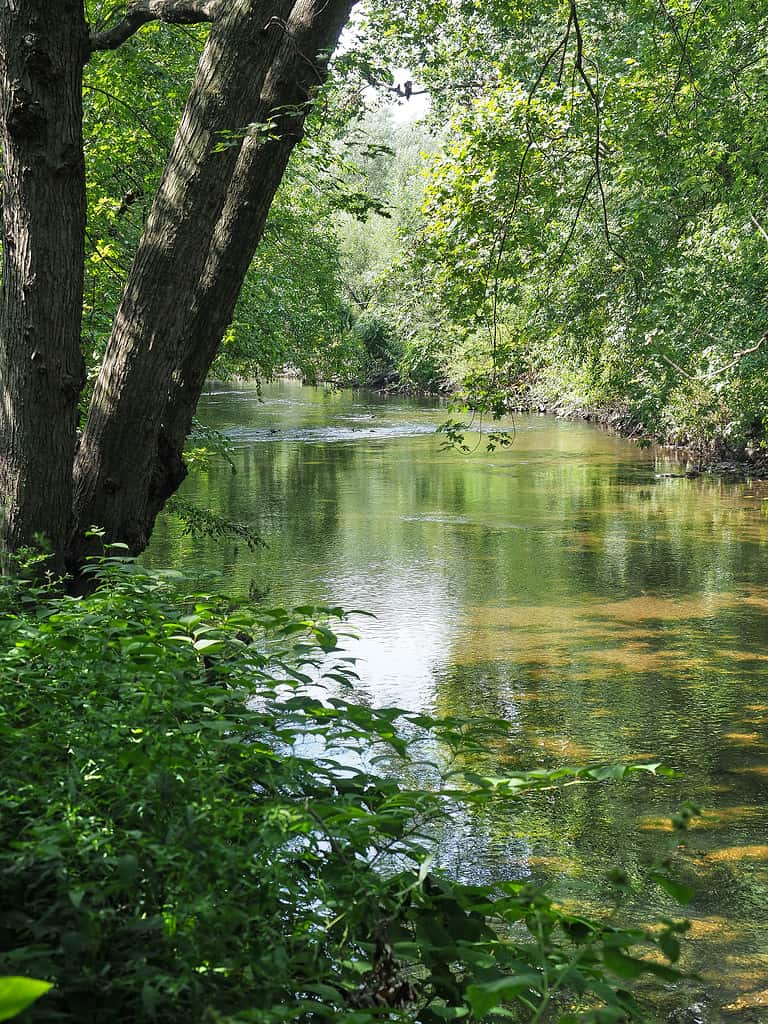
The Bronx River is approximately 24 miles long and flows from southeast New York.
©RoySmith, CC BY-SA 4.0 – License
The Bronx River is one of the most snake-infested rivers in New York. It is approximately 24 miles long and flows from southeast New York. Interestingly, it was named after the colonial settler Jonas Bronck and is the only freshwater river in New York City.
Brown Snake
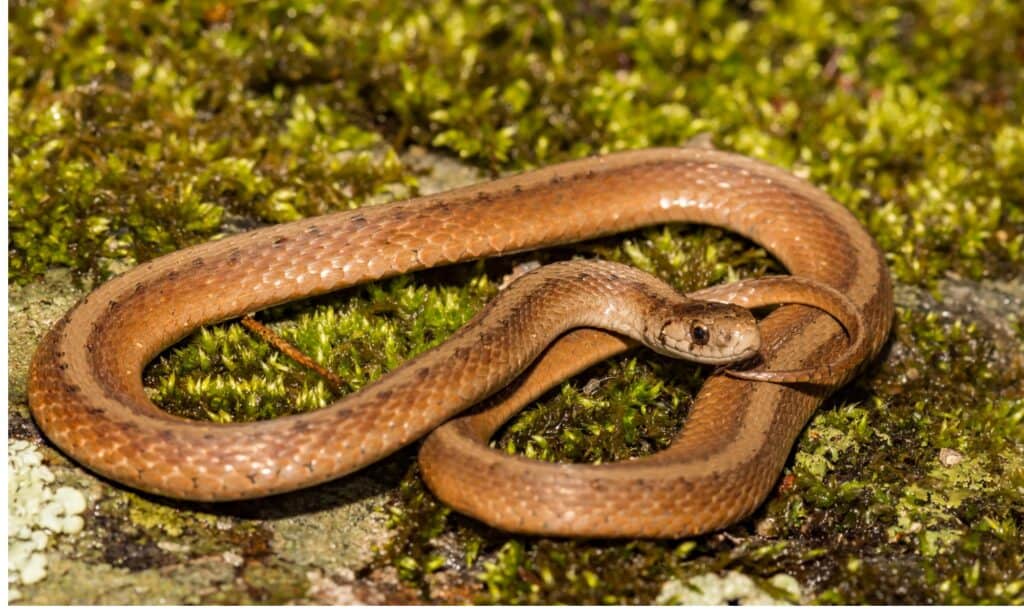
The brown snake usually has two rows of dark spots on their back and a dark streak along the side of their heads.
©iStock.com/JasonOndreicka
Brown snakes are on the smaller side, usually brown in color, but can also be yellow, grayish-brown, or red. They normally have two rows of dark spots on their back and a dark streak along the side of their heads. Furthermore, they have light brown to white bellies. As a result, they are sometimes mistaken for copperheads. These snakes frequently occur in residential areas. Therefore, they have a reputation as a “city snake.” They are most active at night and eat invertebrates like earthworms and slugs.
Common Garter Snake
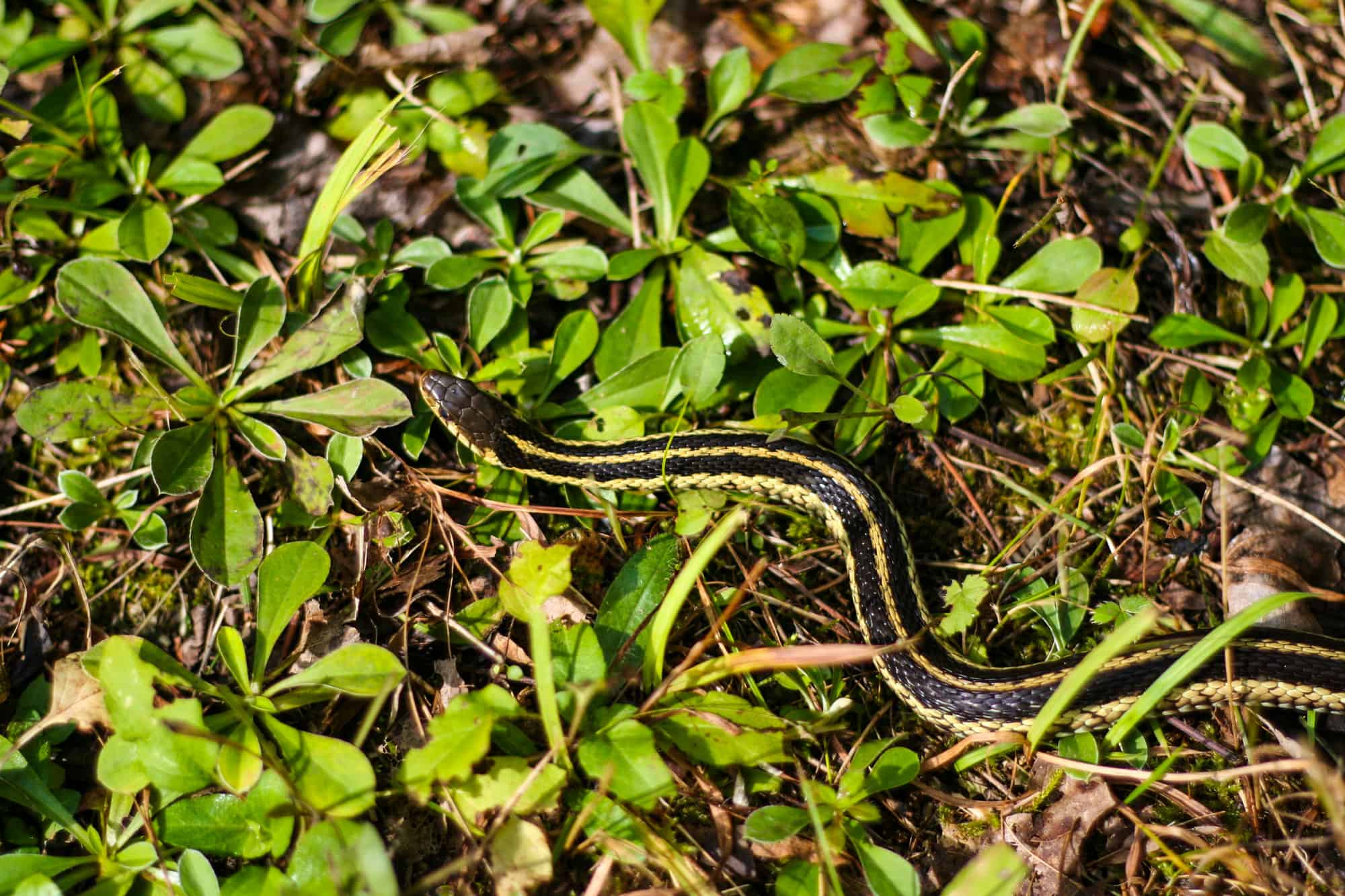
The common garter snake comes in various colors, including blue, green, orange, brown, black, yellow, gold, and red.
©iStock.com/Ingrid R Kostron
Common Garter snakes are common throughout the United States but are indigenous to North America. They come in various colors, including blue, green, orange, brown, black, yellow, gold, and red. Also, they like living near water, such as rivers, marshes, and ponds.
These snakes are diurnal. In the summer, they are more active during the morning, and in winter, they are more active during warmer afternoons. Furthermore, they are very good at catching fast-moving creatures such as tadpoles and fish. Common garter snake’s diet varies as they prey on the following animals:
- Earthworms
- Amphibians
- Leaches
- Lizards
- Crayfish
- Small birds
- Rodents
Hutchinson River: One of the Most Snake-Infested Rivers in New York

The Hutchison River originates in Scarsdale.
©Jim.henderson, Public domain, via Wikimedia Commons – License
The Hutchinson River is one of the most snake-infested rivers in New York. It is a freshwater stream in the Bronx and Southern Westchester County in New York. This river originates in Scarsdale. Furthermore, it is named after Anne Hutchinson, a settler that arrived from Rhode Island in 1642. Sadly, she and all except one of her children were killed the following year in Kieft’s war by a group of Native Americans.
Copperhead Snake
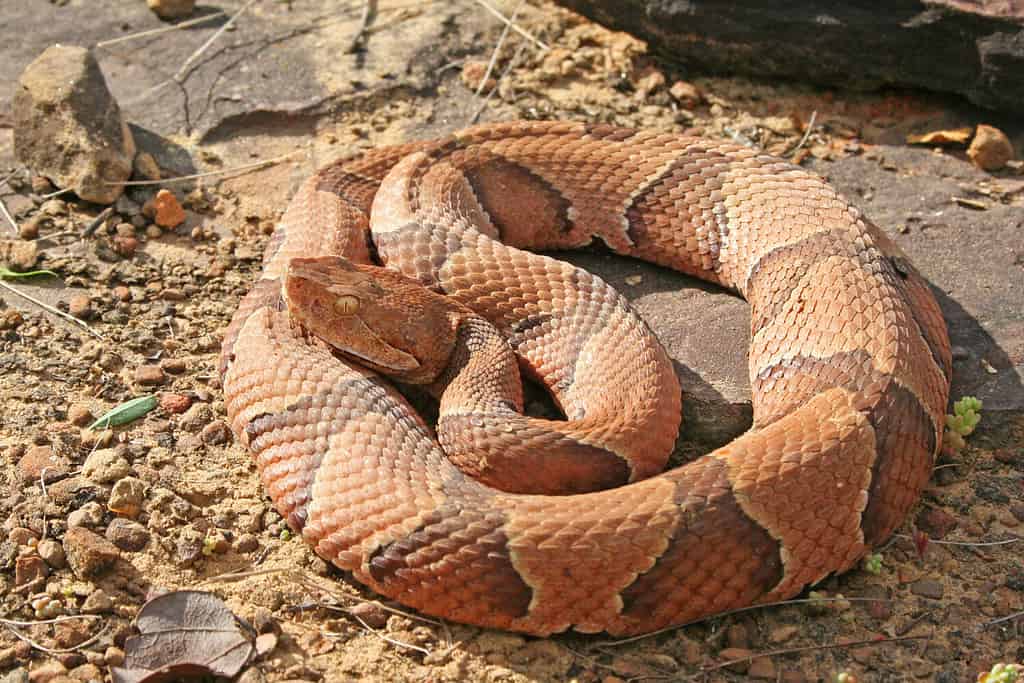
Copperheads occur in North America and Mexico.
©Creeping Things/Shutterstock.com
The Copperhead snake originated in North America and is a very venomous pit viper. These snakes sometimes freeze when encountering humans instead of slithering away because they are very well camouflaged. However, they will bite humans if accidentally stepped on or feel threatened when people unknowingly come too close. These snakes are quite plump, and they have broad heads. Additionally, they are pale tan to pinkish-tan in color with a series of 10 – 18 crossbands on their bodies. Males are normally bigger than females.
Copperheads occur in North America and Mexico. They occupy many diverse habitats but can be found near the water. Also, they are highly terrestrial but have been known to climb trees too. Copperhead snakes hunt alone in winter but can retreat to hibernate in caves alongside Timber rattlesnakes or black rat snakes. During scorching hot days, these snakes are active at night but are primarily diurnal during summer and spring.
Furthermore, they are ambush predators and will wait for their prey to come to them. Juvenile copperheads will use their brightly colored tail to lure prey like lizards and frogs. This behavior is called caudal luring.
Eastern Racer

Eastern racers spend most of their time on the ground but are also very good at climbing trees.
©Matt Jeppson/Shutterstock.com
The eastern racer is a nonvenomous snake that belongs to the Colubridae family. They are endemic to Central and North America. There are 11 subspecies of the eastern racer. However, most of them are solid-colored. Examples include brown racers, tan racers, black racers, green racers, and blue racers. All the subspecies are lighter colored underneath, yellow, white, or tan in color.
These snakes occur near the water yet can also be found in deserts, sandhills, prairies, swamps, and suburbia. Additionally, they are solitary snakes and are only active between the months of March to October. However, in winter, they hibernate communally. Eastern racers spend most of their time on the ground but are also very good at climbing trees.
Eastern racers are inquisitive snakes who have outstanding eyesight. Also, as their name states, they are very fast and will most likely flee from potential predators. However, if they are cornered, they will put up a mighty fight and deliver a striking, painful bite. In addition, they are not easy to handle and will writhe and release a disgusting-smelling musk when handled incorrectly.
Summary Of The Most Snake-Infested Rivers In New York
| Rank | River |
|---|---|
| 1 | Hudson River |
| 2 | Bronx River |
| 3 | Hutchinson River |
The photo featured at the top of this post is © Akitzhaber/Shutterstock.com
Thank you for reading! Have some feedback for us? Contact the AZ Animals editorial team.






